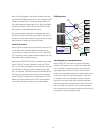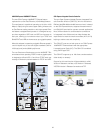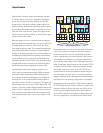
26
HiperSockets, a function unique to the zSeries, provides
a “TCP/IP network in the server” that allows high-speed
any-to-any connectivity among virtual servers (TCP/IP
images) and LPARs within a zSeries system without any
physical cabling. HiperSockets decreases network latency
and increases bandwidth between combinations of Linux,
z/OS and z/VM virtual servers. These OS images can be
fi rst level (directly under an LPAR), or second level images
(virtual servers under z/VM).
With new support for up to 16 HiperSockets the z990 pro-
vides four times more HiperSockets, and up to 4,096 TCP/
IP images (stack) connections, which is also four times
more capacity than the z900. The increased HiperSockets
capacity and expanded connectivity provides additional
fl exibility in designing the networking to accommodate con-
solidated and multiple partitioned systems. HiperSockets
can be divided among Logical Channel SubSystems for
separation between various LPARs, while at the same time
a single LPAR could have access to all 16 HiperSockets
if
the HiperSockets all are assigned to the same LCSS.
A HiperSockets channel also supports spanned chan-
nels in order to communicate between LPARs connected
to different LCSSs. HiperSockets (IQD CHPID type) can
be confi gured to Channel SubSystems and transparently
shared by any or all confi gured LPARs without regard to
the LCSS to
which the LPAR is confi gured. This means one
HiperSockets
could be common to all 30 z990 LPARs. This
support is exclusive to z990. Different HiperSockets can be
used for security (separation of traffi c, no external wire-tap-
ping, monitoring) and performance and management rea-
sons (separate sysplex traffi c, Linux or non-sysplex LPAR
traffi c).
HiperSockets does not use an external network, therefore,
it can free up system and network resources, reducing
attachment cost while improving availability and perfor-
mance. HiperSockets can have signifi cant value in server
consolidation, for example, by connecting multiple Linux
virtual servers under z/VM to z/OS LPARs within the same
z990. Furthermore, HiperSockets can be utilized by TCP/IP
in place of XCF for sysplex connectivity between images
which exist in the same server. Thus z/OS TCP/IP uses
HiperSockets for connectivity between sysplex images in
the same server and uses XCF for connectivity between
images in different servers. Management and administration
cost reductions over existing confi gurations are possible.
HiperSockets acts like any other TCP/IP network interface,
so TCP/IP features like IP Security (IPSec) in Virtual Private
Networks (VPN) and Secure Sockets Layer (SSL) can be
used to provide heightened security for fl ows within the
same CHPID. HiperSockets supports multiple frame sizes,
which is confi gured on a per HiperSockets CHPID basis.
HiperSockets
LCSS0 LCSS1
LPAR
15
LPAR
14
LPAR
18
MIF-1 MIF-2 MIF-F MIF-1 MIF-2 MIF-3 MIF-F
CHPID
00
CHPID
02
CHPID
01
CHPID
FF
PCHID
010B
PCHID
010D
PCHID
010C
PCHID
020A
CHPID
04
SPAN
CHPID
00
CHPID
05
Share
CHPID
01
PCHID
0245
PCHID
0246
CHPID
22
PCHID
0248
CHPID
FF
PCHID
0249
CHPID
03
Share
Linux
HiperSockets CHPID 04
z/VM
LPAR
17
z/OS
HiperSockets CHPID 05
HiperSockets CHPID 03
LPAR
30
LinuxLinux
z/VM
LPAR 1


















